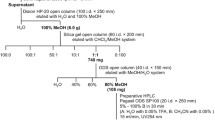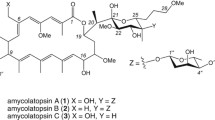Abstract
Mycobacterium sp. 7E1B1W and seven other mycobacterial strains known to degrade hydrocarbons were investigated to determine their ability to metabolize the piperazine ring, a substructure found in many drugs. Cultures were grown at 30°C in tryptic soy broth and dosed with 3.1 mM N-phenylpiperazine hydrochloride; samples were removed at intervals and extracted with ethyl acetate. Two metabolites were purified from each of the extracts by high-performance liquid chromatography; they were identified by mass spectrometry and 1H nuclear magnetic resonance spectroscopy as N-(2-anilinoethyl)acetamide and N-acetyl-N′-phenylpiperazine. The results show that mycobacteria have the ability to acetylate piperazine rings and cleave carbon-nitrogen bonds.



Similar content being viewed by others
References
Adjei MD, Heinze TM, Deck J, Freeman JP, Williams AJ, Sutherland JB (2006) Transformation of the antibacterial agent norfloxacin by environmental mycobacteria. Appl Environ Microbiol 72:5790–5793
Adjei MD, Heinze TM, Deck J, Freeman JP, Williams AJ, Sutherland JB (2007) Acetylation and nitrosation of ciprofloxacin by environmental strains of mycobacteria. Can J Microbiol (in press)
Beam HW, Perry JJ (1974) Microbial degradation of cycloparaffinic hydrocarbons via co-metabolism and commensalism. J Gen Microbiol 82:163–169
Blevins WT, Perry JJ (1972) Metabolism of propane, n-propylamine, and propionate by hydrocarbon-utilizing bacteria. J Bacteriol 112:513–518
Brezna B, Khan AA, Cerniglia CE (2003) Molecular characterization of dioxygenases from polycyclic aromatic hydrocarbon-degrading Mycobacterium spp. FEMS Microbiol Lett 223:177–183
Brooke EW, Davies SG, Mulvaney AW, Pompeo F, Sim E, Vickers RJ (2003) An approach to identifying novel substrates of bacterial arylamine N-acetyltransferases. Bioorgan Med Chem 11:1227–1234
Bryskier A, Lowther J (2002) Fluoroquinolones and tuberculosis. Expert Opin Invest Drugs 11:233–258
Chen Y, Rosazza JPN, Reese CP, Chang H-Y, Nowakowski MA, Kiplinger JP (1997) Microbial models of soil metabolism: biotransformations of danofloxacin. J Ind Microbiol Biotechnol 19:378–384
Cohen MR, Hinsch E, Palkoski Z, Vergona R, Urbano S, Sztokalo J (1982) The cardiovascular and autonomic properties of N-phenylpiperazine (NPP) in several animal models. J Pharmacol Exp Ther 223:110–119
Combourieu B, Poupin P, Besse P, Sancelme M, Veschambre H, Truffaut N, Delort A-M (1998) Thiomorpholine and morpholine oxidation by a cytochrome P450 in Mycobacterium aurum MO1. Evidence of the intermediates by in situ 1H NMR. Biodegradation 9:433–442
Dalhoff A, Bergan T (1998) Pharmacokinetics of fluoroquinolones in experimental animals. In: Kuhlmann J, Dalhoff A, Zeiler H-J (eds) Quinolone antibacterials. Springer-Verlag, Berlin, Germany, pp 179–206
Delort A-M, Combourieu B (2001) In situ 1H NMR study of the biodegradation of xenobiotics: Application to heterocyclic compounds. J Ind Microbiol Biotechnol 26:2–8
Dmitrenko GN, Gvozdyak PI, Udod VM (1987) Selection of destructor microorganisms for heterocyclic xenobiotics. Khim Tekhnol Vody (Engl Transl) 9:442–445
Domagala JM, Hagen SE (2003) Structure-activity relationships of the quinolone antibacterials in the new millennium: some things change and some do not. In: Hooper DC, Rubinstein E (eds) Quinolone antimicrobial agents, 3rd edn. ASM Press, Washington, DC, USA, pp 3–18
Emtiazi G, Knapp JS (1994) The biodegradation of piperazine and structurally-related linear and cyclic amines. Biodegradation 5:83–92
Grover JK, Vats V, Uppal G, Yadav S (2001) Anthelmintics: a review. Trop Gastroenterol 22:180–189
Kim Y-H, Engesser K-H, Cerniglia CE (2005) Numerical and genetic analysis of polycyclic aromatic hydrocarbon-degrading mycobacteria. Microb Ecol 50:110–119
Levy AD, Van de Kar LD (1992) Endocrine and receptor pharmacology of serotonergic anxiolytics, antipsychotics and antidepressants. Life Sci 51:83–94
Mjos K (1978) Cyclic amines. In: Grayson M, Eckroth D (eds) Kirk-Othmer Encyclopedia of Chemical Technology, 3rd edn. vol 2. Wiley, New York, NY, USA, pp 295–308
Parshikov IA, Freeman JP, Lay JO, Beger RD, Williams AJ, Sutherland JB (2000) Microbiological transformation of enrofloxacin by the fungus Mucor ramannianus. Appl Environ Microbiol 66:2664–2667
Parshikov IA, Freeman JP, Lay JO, Moody JD, Williams AJ, Beger RD, Sutherland JB (2001) Metabolism of the veterinary fluoroquinolone sarafloxacin by the fungus Mucor ramannianus. J Ind Microbiol Biotechnol 26:140–144
Parshikov IA, Heinze TM, Moody JD, Freeman JP, Williams AJ, Sutherland JB (2001) The fungus Pestalotiopsis guepini as a model for biotransformation of ciprofloxacin and norfloxacin. Appl Microbiol Biotechnol 56:474–477
Pauliukonis LT, Musson DG, Bayne WF (1984) Quantitation of norfloxacin, a new antibacterial agent in human plasma and urine by ion-pair reverse-phase chromatography. J Pharm Sci 73:99–102
Payton M, Auty R, Delgoda R, Everett M, Sim E (1999) Cloning and characterization of arylamine N-acetyltransferase genes from Mycobacterium smegmatis and Mycobacterium tuberculosis: increased expression results in isoniazid resistance. J Bacteriol 181:1343–1347
Payton M, Mushtaq A, Yu T-W, Wu L-J, Sinclair J, Sim E (2001) Eubacterial arylamine N-acetyltransferases–identification and comparison of 18 members of the protein family with conserved active site cysteine, histidine and aspartate residues. Microbiology 147:1137–1147
Pietsch J, Hampel S, Schmidt W, Brauch H-J, Worch E (1996) Determination of aliphatic and alicyclic amines in water by gas and liquid chromatography after derivatization by chloroformates. Fresenius J Anal Chem 355:164–173
Poupin P, Truffaut N, Combourieu B, Besse P, Sancelme M, Veschambre H, Delort AM (1998) Degradation of morpholine by an environmental Mycobacterium strain involves a cytochrome P-450. Appl Environ Microbiol 64:159–165
Schneider J, Grosser R, Jayasimhulu K, Xue W, Warshawsky D (1996) Degradation of pyrene, benz [a]anthracene, and benzo [a]pyrene by Mycobacterium sp. strain RJGII-135, isolated from a former coal gasification site. Appl Environ Microbiol 62:13–19
Sheng C-Q, Zhang W-N, Ji H-T, Song Y-L, Yang S, Zhou Y-J, Zhu J, Lü J-G (2003) Synthesis and antifungal activity of 1-(1,2,4-triazolyl-1H-1-yl)-2-(2,4-difluorophenyl)-3-(4-substituted benzyl-1-piperazinyl)-2-propanols. Acta Pharm Sin 38:665–670 [in Chinese]
Tanzi MC, Levi M, Danusso F (1990) Amides from N-phenylpiperazine as low-toxicity activators in radical polymerizations. Polymer 31:1735–1738
Wetzstein H-G, Schmeer N, Karl W (1997) Degradation of the fluoroquinolone enrofloxacin by the brown rot fungus Gloeophyllum striatum: identification of metabolites. Appl Environ Microbiol 63:4272–4281
Wetzstein H-G, Stadler M, Tichy H-V, Dalhoff A, Karl W (1999) Degradation of ciprofloxacin by basidiomycetes and identification of metabolites generated by the brown rot fungus Gloeophyllum striatum. Appl Environ Microbiol 65:1556–1563
Zeiler H-J, Petersen U, Gau W, Ploschke HJ (1987) Antibacterial activity of the metabolites of ciprofloxacin and its significance in the bioassay. Arzneim-Forsch/Drug Res 37:131–134
Acknowledgments
We thank Dr. C. E. Cerniglia for providing the Mycobacterium strains and also thank him and Dr. F. Rafii for helpful comments on the manuscript. This work was supported in part by an appointment to the postgraduate research program at the National Center for Toxicological Research administered by the Oak Ridge Institute for Science and Education through an interagency agreement between the US Department of Energy and the US Food and Drug Administration. The views presented in this article do not necessarily reflect those of the Food and Drug Administration.
Author information
Authors and Affiliations
Corresponding author
Rights and permissions
About this article
Cite this article
Adjei, M.D., Deck, J., Heinze, T.M. et al. Identification of metabolites produced from N-phenylpiperazine by Mycobacterium spp. J Ind Microbiol Biotechnol 34, 219–224 (2007). https://doi.org/10.1007/s10295-006-0189-x
Received:
Accepted:
Published:
Issue Date:
DOI: https://doi.org/10.1007/s10295-006-0189-x




